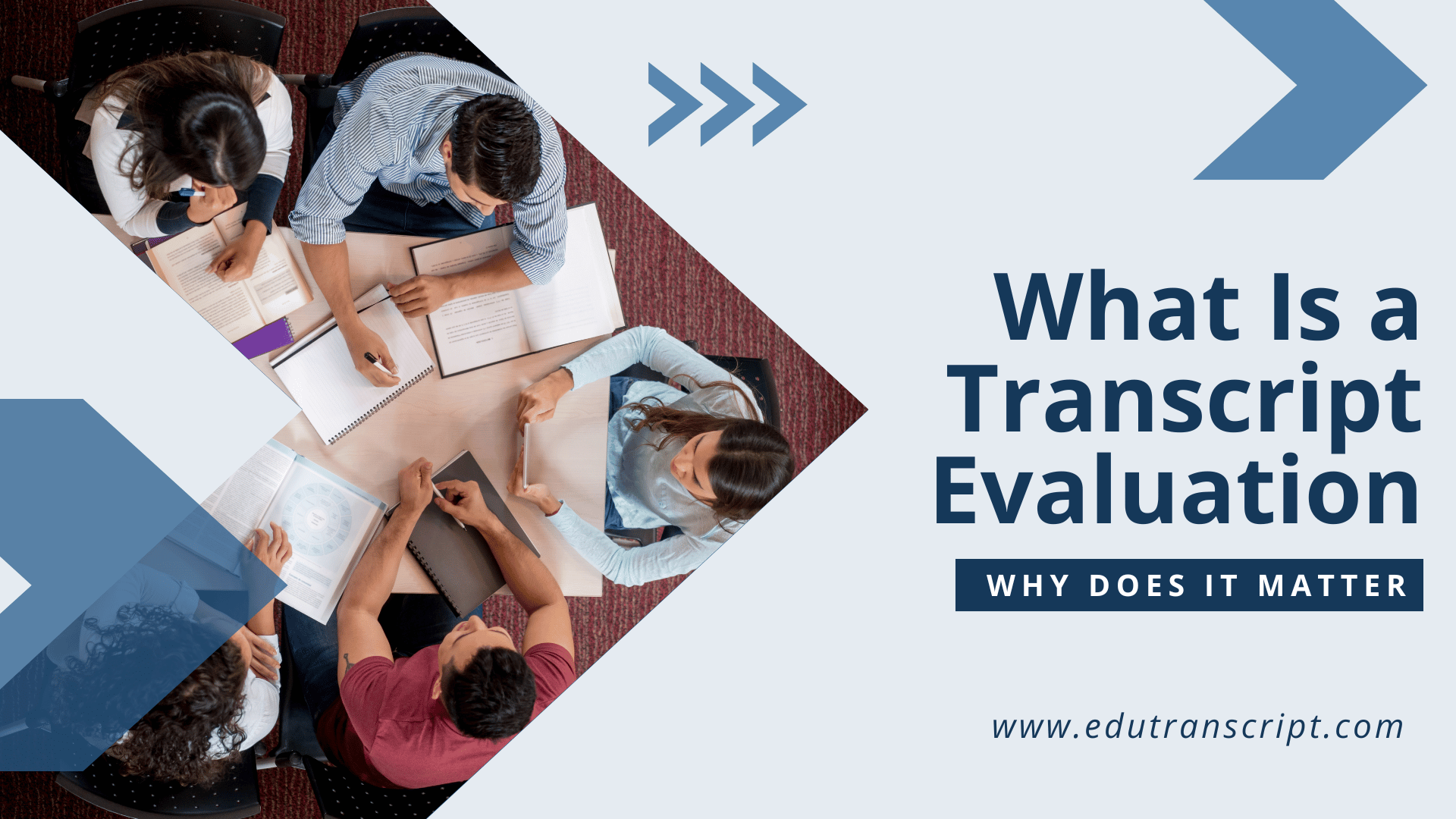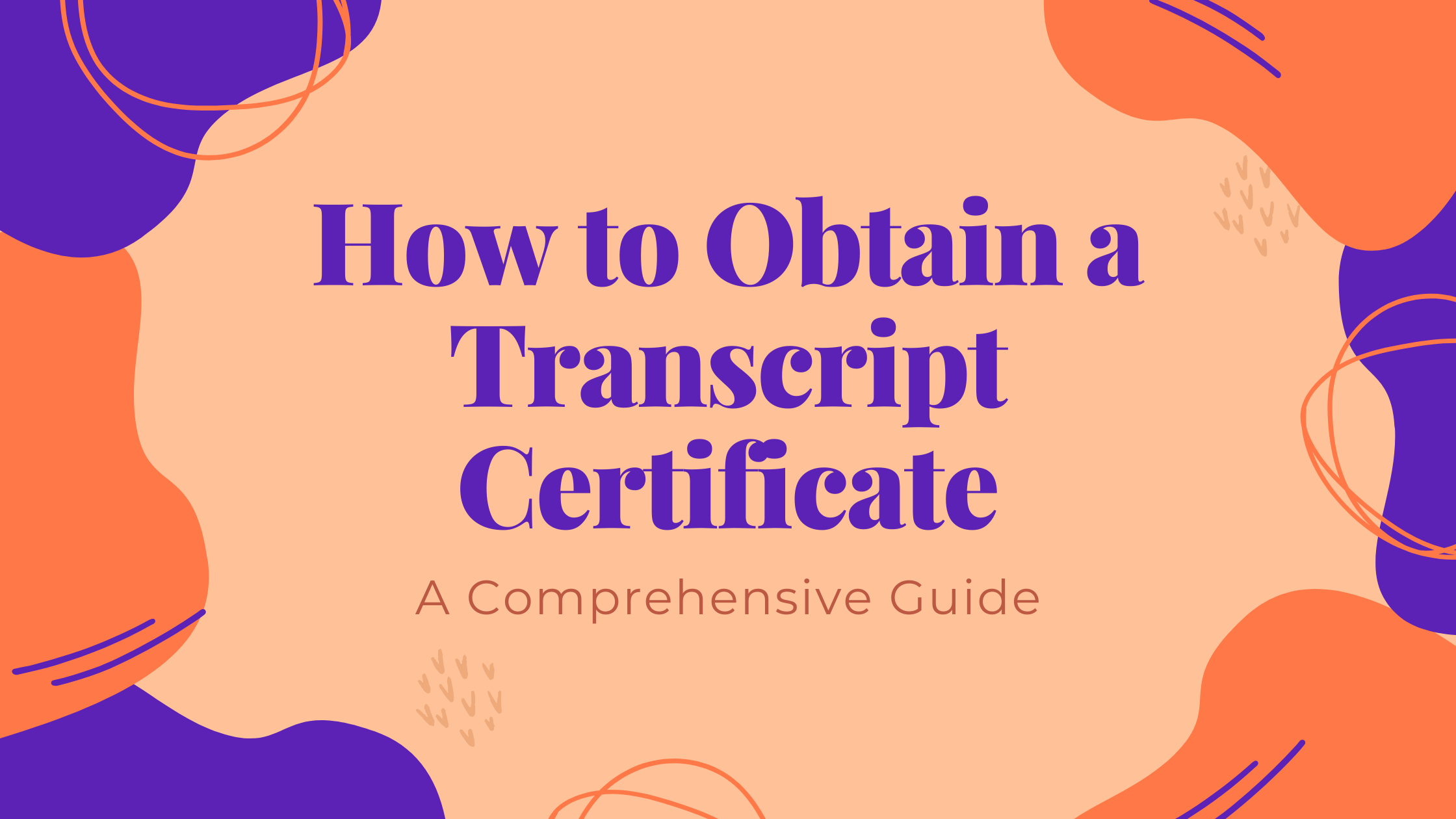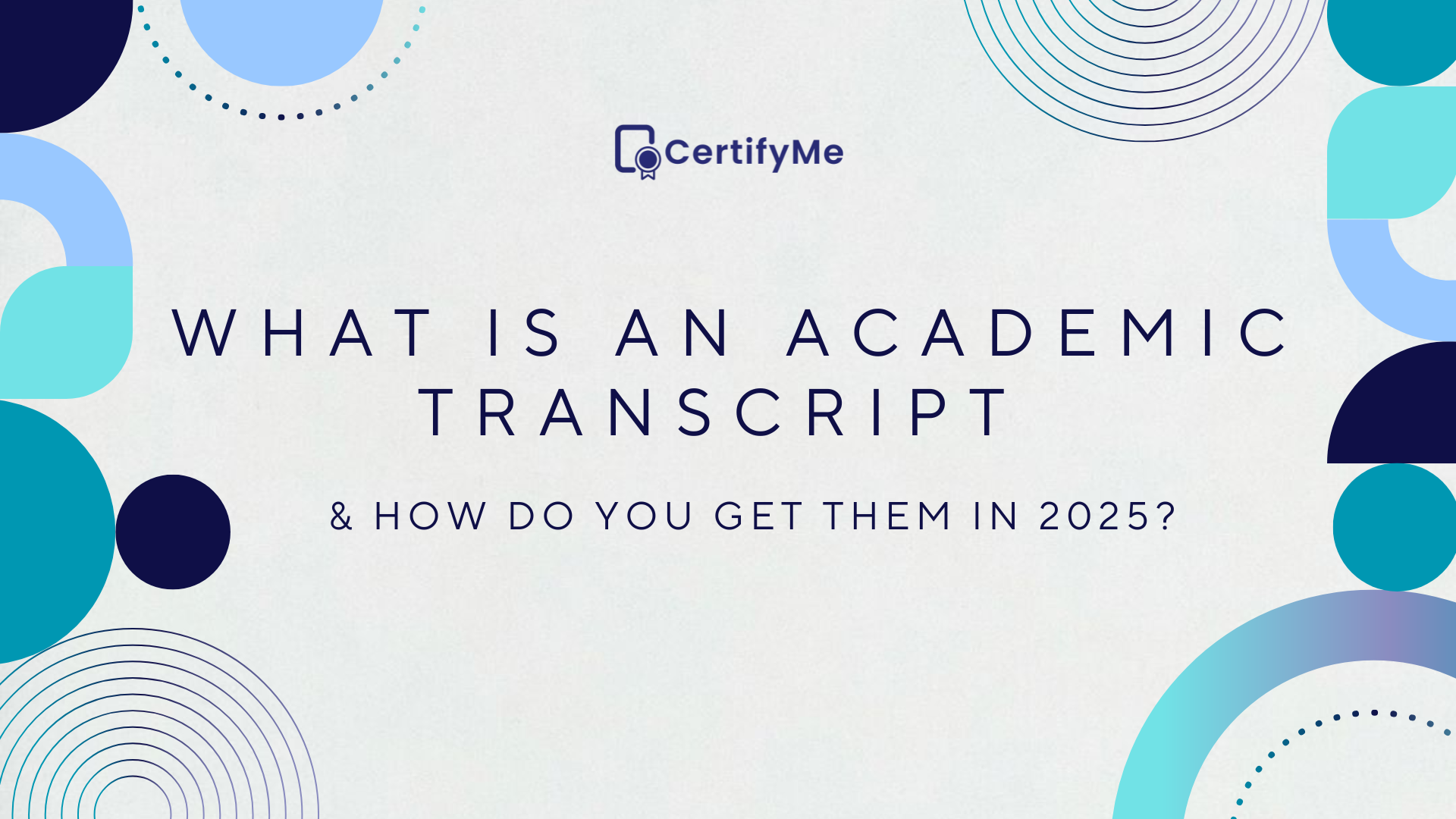Imagine you’ve just completed your studies in a different country, and now you’re dreaming of continuing your education or landing a job in the U.S.
Before you start filling out college applications or job forms, there’s one key step that could make or break your plans: getting your academic transcripts evaluated.
Navigating international education can feel overwhelming, but understanding what goes into transcript evaluation and why it’s important can make the process much smoother. It’s your key to unlocking academic and professional doors in the U.S.
In this blog, we’ll break down what a transcript evaluation really is, why it matters, and how to get started.
What Is a Transcript Evaluation?
A transcript evaluation is a systematic process that assesses academic records from one institution or country and translates them into an equivalent framework understood by another.
This process helps institutions, employers, and licensing boards determine the value of previous educational experiences. They act as a kind of academic “translator” that bridges the gap between different education systems.
A transcript evaluation report typically includes details on degree equivalency, course credits, and GPA conversion. Many agencies provide sample reports on their websites.
To request an evaluation, applicants may need to complete a transcript evaluation form, which can be found on the official websites of recognized evaluation agencies.
Why Do You Need It?
Imagine applying to your dream college, sending in your transcripts from a foreign university, and then waiting—only to realize the admissions committee can’t accurately evaluate your application because they don’t understand how your grades compare to those of U.S. students.
This is exactly why transcript evaluations matter. They ensure that your credentials are assessed fairly and that your academic achievements are fully recognized.
Definition and Purpose
So, what does transcript evaluation really mean?
It’s basically a formal review of your educational records, including your transcripts, degrees, and grades, to determine how your academic qualifications match up to U.S. educational standards.
Here’s what evaluators typically focus on:
-
Your Academic History: This includes your coursework, the subjects you studied, the credit hours you earned, and the grades you received.
-
The Value of Your Degree: Evaluators assess whether your foreign degree is equivalent to a U.S. degree, such as a bachelor’s, master’s, or Ph.D.
-
Grade Conversion: If your home country uses a different grading scale (e.g., a 10-point scale or letter grades), evaluators will convert your grades into U.S.-style GPAs (on a 4.0 scale).
-
Educational Standards Comparison: They’ll compare the educational system in your country to the U.S. system to see if your academic background meets U.S. standards.
Why Does This Matter?
This evaluation process is crucial for several reasons:
-
For University Admissions: U.S. colleges need to know if your previous coursework meets their academic requirements. A transcript evaluation helps them determine whether to admit you, whether you’re eligible for transfer credits, and if you meet any specific prerequisites for your program.
-
For Employment: Some jobs, especially those requiring a specific level of education (like healthcare, engineering, or teaching), may require a verified transcript evaluation to confirm your academic qualifications.
-
For Immigration or Professional Licensure: In certain cases, immigration offices and licensing boards (such as those for doctors, lawyers, or accountants) may also require a transcript evaluation to verify your academic credentials.
Without this comparison, it’s nearly impossible for institutions to understand how your foreign qualifications fit into the U.S. system—and that can make it harder for you to achieve your academic or professional goals.
Types of Transcript Evaluations
Not all transcript evaluations are created equal.
Different situations call for different types, and knowing which one you need can save you time, money, and headaches.
-
International Transcript Evaluation: This is tailored for students who earned their credits abroad. It often involves comparing foreign coursework to U.S. academic requirements.
-
Course-by-Course Transcript Evaluation: Want a detailed breakdown of each class you took, including grades and credit hours? This is the evaluation you’ll need. It’s especially common when applying to U.S. colleges.
-
Official Transcript Evaluation: Many universities will require you to submit official, sealed transcripts directly from your school. This helps confirm the authenticity of your records.
-
Academic Transcript Evaluation: This type looks at the bigger picture, analyzing your entire educational journey, including your degree and GPA.
By clearly explaining how your international credentials compare to U.S. educational standards, transcript evaluations help pave the way for academic success, professional advancement, and smoother transitions in your academic journey.
Pro tip: Before choosing an evaluation type, check the specific requirements of the institution you’re applying to. Picking the right one can make all the difference.
The Transcript Evaluation Process
Getting a transcript evaluation might sound intimidating at first, but it’s really just a series of straightforward steps.
Whether you’re applying to a U.S. university, pursuing a professional license, or seeking employment, understanding the process can save you time, money, and unnecessary stress.
Here’s a breakdown of the key steps involved in a typical transcript evaluation:
Step 1: Collect Your Transcripts
The first step in the process is to gather your academic transcripts from your previous educational institutions.
These transcripts are official records that list the courses you’ve completed, your grades, and any degrees you’ve earned.
Here’s what you need to know when collecting your transcripts:
-
Sealed and Stamped Transcripts: Many transcript evaluation services require official transcripts, which must be sealed and stamped by your institution. This ensures that the documents haven’t been altered or tampered with.
-
Requesting Transcripts: If you don’t already have your official transcripts, contact your previous school or university to request them. Some schools may charge a small fee for issuing official transcripts.
-
Translated Documents (if applicable): If your transcripts are in a language other than English, you may need to obtain certified translations. Some evaluation services offer translation services as part of their package, while others may require you to submit translated documents separately.
Step 2: Choose an Evaluation Service
Once you have your transcripts in hand, the next step is to select a reputable transcript evaluation service.
This is an important decision because not all evaluation agencies are recognized by every institution.
Here are some tips for choosing the right service:
-
Check Accreditation: Look for evaluation services that are accredited by recognized organizations, such as the National Association of Credential Evaluation Services (NACES) or the Association of International Credential Evaluators (AICE). These organizations set high standards for evaluation accuracy and reliability.
-
Confirm Institutional Recognition: Make sure the evaluation service you choose is accepted by the university, employer, or licensing board you’re applying to. Some institutions have specific lists of approved evaluators.
-
Compare Evaluation Types: Different services offer different types of evaluations, such as course-by-course evaluations, document-by-document evaluations, and degree equivalency evaluations. Choose the one that best fits your needs (we’ll cover these in more detail later).
Step 3: Submit Your Request
After selecting an evaluation service, you’ll need to submit your transcript evaluation request.
Here’s what to expect during this step:
-
Application Form: Most evaluation services require you to fill out an online form with your personal information, educational background, and the type of evaluation you’re requesting.
-
Evaluation Fees: Transcript evaluations aren’t free. Fees vary depending on the type of evaluation, the organization’s policies, and any additional services (like rush processing or translation).
-
Supporting Documents: In addition to your transcripts, you may be asked to submit additional documents, such as a copy of your diploma, course descriptions, or proof of identity (e.g., a passport or driver’s license). Be sure to carefully follow the instructions provided by the evaluation service to avoid delays.
Step 4: Wait for the Evaluation
Once you’ve submitted your request, it’s time to wait while the evaluation service processes your documents.
This part of the process may take anywhere from a few days to several weeks, depending on the type of evaluation and the organization’s workload.
Here are some factors that can affect processing times:
-
Type of Evaluation: Basic document-by-document evaluations are usually faster than detailed course-by-course evaluations, which require more in-depth analysis.
-
Busy Seasons: During peak times (like college application deadlines), evaluation services may experience higher demand, which can lead to longer wait times.
-
Document Completeness: Make sure you’ve submitted all required documents to avoid delays. Missing or incomplete documentation is one of the most common reasons for processing delays.
Step 5: Receive Your Evaluation Report
After the evaluation is complete, you’ll receive a detailed evaluation report.
This report is the final product of the evaluation process and serves as your official credential assessment.
Here’s what a typical evaluation report may include:
-
Degree Equivalency: A statement indicating how your foreign degree compares to a U.S. degree (e.g., “equivalent to a U.S. bachelor’s degree in Business Administration”).
-
Course Equivalencies (for course-by-course evaluations): A breakdown of each course you’ve completed, including U.S. credit hour and grade equivalents. This is especially useful if you’re applying for transfer credits.
-
GPA Conversion: Many evaluation reports include a U.S.-style Grade Point Average (GPA) based on your foreign grades. This helps admissions committees and employers assess your academic performance more easily.
-
Additional Notes: Some evaluation reports may include notes about your educational system, the grading scale used in your home country, or any special considerations (like professional licenses or honors).
Transcript Evaluation Guidelines and System
The transcript evaluation system operates on a set of standardized guidelines to ensure fairness, accuracy, and consistency in evaluating foreign academic credentials.
This framework plays a crucial role in translating your international education into terms that U.S. institutions can easily understand.
Below, we’ll explore the key aspects of the transcript evaluation guidelines and system so you know what to expect:
Standardized Framework
Transcript evaluators follow standardized criteria to assess educational equivalency. This ensures that your evaluation is accurate, widely recognized, and comparable to other evaluations.
Here are some key elements of the framework:
-
Credit Conversion: Evaluators convert foreign academic credits into U.S. credit hour equivalents.
-
Grade Conversion: Your foreign grades are translated into U.S. grading scales (typically A-F or 4.0 GPA scale).
-
Degree Equivalency: Evaluators determine how your foreign degree compares to U.S. degree standards.
Required Documents for Transcript Evaluation
To complete your transcript evaluation, you’ll need to provide specific documents.
Commonly required documents include:
-
Official Academic Transcripts: These must be sealed and stamped by your previous institution to confirm their authenticity.
-
Diplomas and Certificates: You may need to submit copies of any diplomas or certificates you’ve earned, especially for degree equivalency evaluations.
-
Course Descriptions or Syllabi (for detailed evaluations): If you’re requesting a course-by-course evaluation, you may be asked to provide course descriptions or syllabi to help evaluators determine how your coursework aligns with U.S. standards.
-
Certified Translations (if applicable): If your transcripts are in a language other than English, you’ll need to submit certified translations. Some evaluation services offer translation as part of their package, while others may require you to arrange translations separately.
-
Proof of Identity: Some evaluation services may ask for additional documentation, such as a passport or driver’s license, to verify your identity.
Institutional Policies and Requirements
It’s important to note that different universities, employers, and licensing boards may have unique policies and requirements for transcript evaluation.
Before starting the evaluation process, make sure you understand the specific guidelines of the institution you’re applying to.
Here are some key factors to consider:
-
Approved Evaluation Services: Some institutions have a list of approved evaluation services, so check their website or contact their admissions office to ensure you’re using a recognized evaluator.
-
Evaluation Type: Different institutions may require different types of evaluations. For example, some universities may accept document-by-document evaluations, while others may require course-by-course evaluations for transfer credit purposes.
-
Additional Documentation: Certain institutions may request additional documentation, such as proof of English proficiency, professional licenses, or work experience, as part of the evaluation process.
Global Educational Standards
The transcript evaluation system is designed to accommodate a wide range of educational systems from around the world.
Here are some examples of how global standards are applied:
-
Grading Scale Conversion: Evaluators are familiar with grading scales from various countries and can accurately convert your grades into U.S. equivalents.
-
Credit Hour Conversion: Different countries use different systems for measuring academic workload (e.g., ECTS credits in Europe or contact hours in India). Evaluators convert these measurements into U.S. credit hours to provide a consistent basis for comparison.
-
Degree Comparability: Evaluators assess how your degree aligns with U.S. degree standards, taking into account factors like program length, curriculum, and academic rigor.
By understanding the transcript evaluation guidelines and system, you’ll be better equipped to navigate the evaluation process and ensure that your academic credentials are accurately assessed. This knowledge can also help you avoid common pitfalls, such as submitting incomplete documentation or choosing the wrong type of evaluation.
How Long Does Transcript Evaluation Take?
One of the most common questions is, “How long does transcript evaluation take?”
Well, it depends. On average, the process can take anywhere from 2 to 8 weeks, but this varies based on factors like:
-
The Type of Evaluation: A basic evaluation may be faster than a detailed course-by-course one.
-
The Organization’s Workload: Busy seasons can mean longer wait times.
-
Your Documentation: Make sure everything is in order to avoid delays!
Transcript Evaluation Cost
One of the most common questions students ask before starting the transcript evaluation process is, “How much does transcript evaluation cost?”
The answer depends on a few key factors, including the type of evaluation you need, the evaluation agency you choose, and whether you require additional services like expedited processing or certified translations.
Let’s break down the typical costs associated with transcript evaluations and explore how to plan your budget effectively:
Basic Evaluation Cost
If you’re looking for a simple, document-by-document evaluation to confirm your degree equivalency, you’ll typically pay less than you would for a more detailed report.
- Average Cost: $100 to $200 (rough figures)
- Best For: Employment applications, professional licenses, or situations where a general evaluation is sufficient.
This type of evaluation focuses on assessing your overall academic achievements, such as whether your bachelor’s degree is equivalent to a U.S. bachelor’s degree.
It’s often faster and less expensive than detailed evaluations.
Comprehensive Evaluation Cost
For more detailed evaluations, like course-by-course evaluations, the cost increases due to the extra time and effort required to review each course you’ve completed and convert it into U.S. credit and grade equivalents.
-
Average Cost: $200 to $300 (rough figures)
-
Best For: Students applying to U.S. colleges and universities Transfer students who want to receive credit for previous coursework Licensing boards that require a breakdown of your academic history
This type of evaluation includes detailed information about each course you’ve taken, including the U.S. equivalent credit hours, grades, and GPA.
It’s commonly required for college admissions, especially if you’re applying for advanced standing or transfer credit.
Specialty Evaluation Cost
In some cases, you may need a specialty evaluation that goes beyond the standard course-by-course or document-by-document evaluations.
These evaluations may be required for specific fields, such as healthcare, engineering, or law, where licensing boards have strict requirements for evaluating foreign credentials.
-
Average Cost: $300 and up (rough figures)
-
Best For: Professionals applying for licenses in specialized fields (e.g., doctors, nurses, engineers) Students applying to highly competitive programs with strict evaluation criteria Situations requiring additional documentation, such as course descriptions, syllabi, or clinical training records
Since these evaluations are more complex, they tend to be more expensive and may require additional time for processing.
Additional Costs and Fees
In addition to the base evaluation cost, you may encounter extra fees for certain services or circumstances. Here are some common add-ons to be aware of:
-
Expedited Processing: Need your evaluation quickly? Many agencies offer expedited services for an additional fee, which can range from $50 to $200 depending on the processing speed you choose.
-
Certified Translations: If your transcripts are not in English, you may need to pay for certified translations. Some evaluation agencies offer translation services, while others may require you to arrange this separately. Translation costs can vary widely but typically range from $20 to $50 per page.
-
Additional Copies: Need extra copies of your evaluation report? Agencies often charge a fee (around $10 to $30 per copy) for additional or official copies sent to institutions.
-
Document Authentication: Some agencies may charge extra for verifying the authenticity of your documents, especially if this involves contacting your previous institution or using international verification services.
-
Shipping Fees: If you need a physical copy of your evaluation report sent to a university, employer, or licensing board, you may need to pay for shipping, especially if it’s being sent internationally.
How to Save Money on Transcript Evaluation
While transcript evaluation is an essential investment in your academic and professional future, there are ways to keep costs under control.
Here are some tips to help you save money:
-
Compare Evaluation Agencies: Not all evaluation agencies charge the same fees. Take the time to compare prices, services, and processing times to find the best fit for your needs and budget.
-
Check Institutional Partnerships: Some universities and employers have partnerships with specific evaluation agencies, which may offer discounted rates or waive certain fees.
-
Plan Ahead: Avoid rush fees by starting the evaluation process early. The standard processing time may be sufficient if you plan ahead, allowing you to skip the extra cost of expedited services.
-
Gather All Required Documents in Advance: Submitting incomplete or incorrect documentation can lead to delays and additional fees, so double-check the requirements before submitting your application.
-
Look for Package Deals: Some evaluation agencies offer package deals that include both evaluation and translation services, which can be more cost-effective than purchasing these services separately
Why Transcript Evaluation Is Worth the Cost
While the cost of transcript evaluation may seem high, it’s important to view it as an investment in your future.
Without a proper evaluation, your foreign academic credentials may not be recognized by U.S. institutions, which could limit your opportunities for higher education, employment, or professional licensing.
By obtaining a thorough, accurate evaluation, you’re essentially opening doors to new academic and career opportunities in the U.S. Whether you’re aiming to enroll in college, land your dream job, or qualify for a professional license, a transcript evaluation is a crucial step in achieving your goals.
Tips for a Smooth Transcript Evaluation
Want to avoid unnecessary stress?
Follow these tips:
-
Know the Requirements: Every evaluation service has different guidelines.
-
Prepare Early: Gather your transcripts, translations, and IDs ahead of time.
-
Follow Up: After submitting your request, confirm that your documents have been received.
-
Keep Copies: Always keep backup copies of your transcripts and forms.
-
Ask Questions: If you’re unsure about anything, reach out for clarification.
Faster, Safer Transcript Evaluations with EduTranscript
Getting your transcript evaluated shouldn’t feel like waiting in line at the DMV — but let’s be honest, for students, university staff, and credential evaluators, it often does.
Students wait for printed copies, universities spend hours confirming their authenticity, and evaluators sift through piles of documents trying to spot errors or fakes. The whole process slows everyone down.
That’s where EduTranscript comes in.
It’s designed to make life easier for students applying to schools or jobs, university registrars handling requests, and evaluation agencies trying to confirm credentials. By moving transcripts to a secure digital platform, EduTranscript helps cut out the paperwork, confusion, and delays that usually cause frustration on all sides.
Here’s how it makes the process faster, simpler, and safer for everyone involved:
-
Simplifies University Workload — Agencies can verify transcripts instantly through links or QR codes, skipping the back-and-forth emails. Automated verification frees up the registrar’s office from endless manual confirmations.
-
Faster Access to Official Transcripts — Students receive their digital transcripts quicker than paper versions, meaning no missed application deadlines.
-
Reduces the Risk of Loss or Damage — No more lost, damaged, or delayed physical copies. Digital storage means peace of mind.
-
Increases Trust in Applications — Verified transcripts give admissions and evaluation agencies confidence in your application.
-
Standardized, Tamper-Proof Transcripts — Digital signatures and secure generation make fraud and errors a thing of the past.
-
Consistent Transcript Format — A clear, uniform layout makes life easier for credential evaluators.
-
Audit Trail and Compliance — Each transcript comes with a traceable record, ensuring transparency and meeting data security standards.
When you replace paperwork with a secure, click-and-confirm system, transcript evaluations stop feeling like a hassle. Students move forward faster, universities save time, and evaluators can trust what they see — right from the start.
Conclusion
A transcript evaluation can significantly impact a student’s or professional’s future, ensuring they receive proper recognition for their past education. By understanding its importance and selecting the right evaluation service, individuals can seamlessly transition into new academic or career opportunities.
To make things smoother, remember a few key tips: choose the right evaluation type, gather your documents early, and double-check the specific requirements of your target institution.
Every step counts, and a little preparation can save you a lot of frustration down the road. If your transcripts aren’t in English, consider certified translations. And don’t forget to follow up after you submit your documents—no one wants their application delayed because of a missing stamp or form!
For universities, adopting EduTranscript isn’t just about going digital — it’s about making the entire transcript evaluation process faster, clearer, and more reliable for everyone involved.
From reducing manual verification work for your staff to helping students avoid delays and giving evaluation agencies instant confidence in your issued documents, EduTranscript creates a seamless experience from start to finish. It’s a simple upgrade that saves time, builds trust, and keeps your institution’s reputation strong.
Curious to learn more?
Book a free demo call today and discover how EduTranscript can help your institution enhance efficiency, reduce manual work, and provide a seamless experience for both your staff and students.
.png)
 Author :
Author : 




